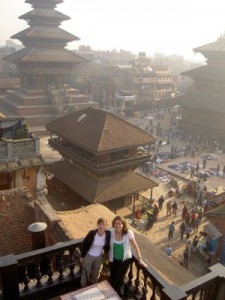 |
We arrive in Bhaktapur “The Ancient city of Asia”.
Previously known as Bhatgaon. Bhat means rice and Gaon means Village. Bhaktapur literally means the City of Devotees.
The city is shaped like a conch shell, one of the emblems of the god Vishnu, and was founded by King Ananda Deva in 889 A.D. The city was originally created with large walls encircling it.
Despite continual invasion and and the natural calamity of 1934 is still rich in arts.
Here Angela and the excellent Jane pose at our rooftop cafe overlooking durbar square. |
| We enter Bhaktapur through the East Gate the famous Lion Gate is far more spectacular but this way, was closer to our Hotel.
We had been traveling all day when we arrived, and coming to the end of our 17 day trip. To be honest, I missed a lot of the details due to fatigue, so if anyone reading, spots a mistake give me a shout.
On the left of this picture you can see a board with entrance prices. I have met people who complained about this sort of think, saying that it was a working town.
Bhaktapur is said to be one of most beautiful places in the world, so I didn’t mind our guide paying £2 to see it. |
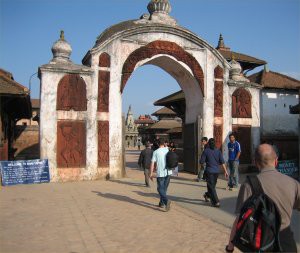 |
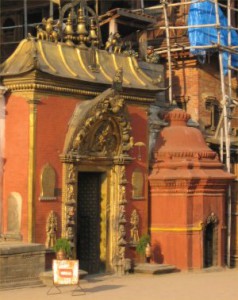 |
We were introduced to our local guide, and he got straight down to business.
The Golden Gate is said to be the most beautiful and richly molded specimen of its kind in the entire world.
In the words of Percy Brown, an eminent English art critic and historian, the Golden Gate is “the most lovely piece of art in the whole kingdom.
It is the entrance to the main courtyard of the palace of 55 windows.
To the the right of the gate, you can see scaffolding where the 55 windowed palace, was being repaired, and sadly we couldn’t visit it.
A Garuda tops the gate and is shown disposing of a number of serpents. The four headed and 16 armed figure of the goddess Taleju Bhawani is below the Garuda
In the top right of the gate, you can see a guard post, where government soldiers prepare for possible “unrest”. |
| The sacred pool, in side a forecourt of the Royal palace, after passing through the Golden Gate.
Nearby was a sacred Hindu shrine. Since Cows are sacred to the Hindu religion, no leather belts or shoes were allowed in here. |
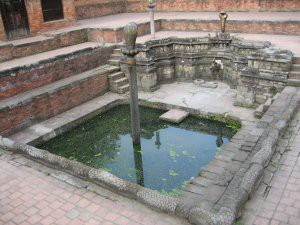 |
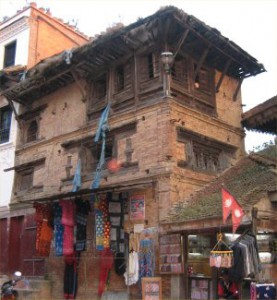 |
A Newari tall house.
The tall houses (3 stories) are built inside the city and ordinary houses up to 2 stories are built outside the Town.
The citizens were reorganized according to the caste system on the basis of their jobs. The higher cast lived inside the town and the lower outside.
Also, the King wanted sunlight to reach all houses. Therefore houses were built in a zigzag and the taller houses got more of the light. |
| Durbar square in Bhaktapur.
The square is one of the most charming architectural showpieces of the valley as it highlights the ancient arts of Nepal.
In the centre of the picture is the Batsala Temple.
On the right is the Dattatraya Temple. It is as old as the Palace of 55 windows.
Built in 1427 it is said to be constructed from the trunk of a single tree. |
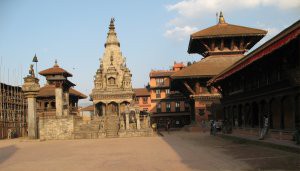 |
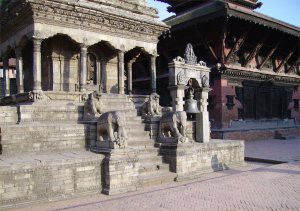 |
A close up of Batsala Temple.
The Temple is built on a square base, all others in Bhaktapur are rectangular.
On the right, is the colossal bronze bell, hung by King Ranjit Malla in 1737 and used to sound the daily curfew.
The bell known to local residents as the Bell of barking dogs, as they go wild whenever it is rung (the dogs I mean, not the local residents).
Nowadays the Bell is chained and locked. |
| Nyatapola Temple.
This five storied pagoda was built by King Bhupatindra Malla in 1702 A.D.
It stands on five terraces, on each of which squat a pair of figures: two famous wrestlers, two elephants, two lions, two griffins, and Baghini and Singhini – the tiger and the lion goddesses.
Each of the paired guardians is said to be 10 times stronger the the previous pair. The lowest pair the two strong men Jaya Malla and Phatta Malla were reputedly ten times stronger then any other men. |
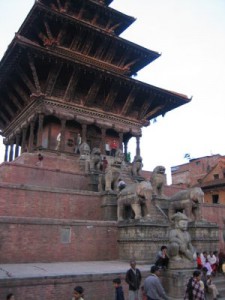 |
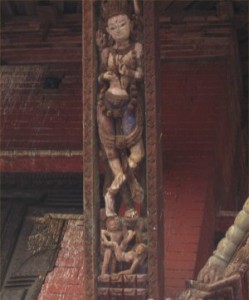 |
The Pashupati Temple has struts like these which feature erotic carvings similar to the ones I saw Khajaraho. |
| Bhairab Nath the distinctive 3 storied Temple.
A temple dedicated to Bhairab the dreadful aspect of Shiva.
In times gone by, to encourage trade, areas were set aside in the town for traders to sleep.
The main square, and area around the buildings were previously used for this purpose.
Today, traders ply their wares in the main square, but in the evening, they probably stay in hotels rather than sleeping next to their stalls. |
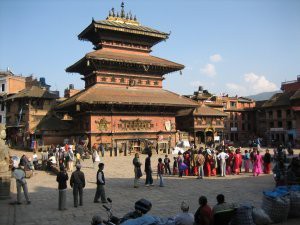 |
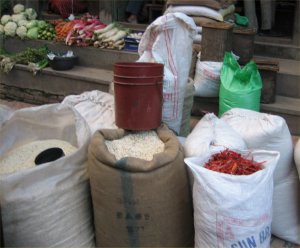 |
I couldn’t believe the sheer bulk of food produce that was on sale.
Tons upon Tons of rice and vegetables were piles high at street stalls.
Made me wonder why we don’t just do that in the UK. |
| A seemingly endless sight of people carrying heavy good through the streets.
I wonder if some of the people I work with, who complain about workload, should be made to do this job for a day !.
This wasn’t just down to people being poor, many of the alleyways, didn’t look like a delivery van could fit down them. |
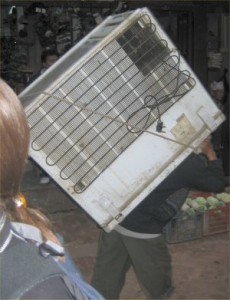 |
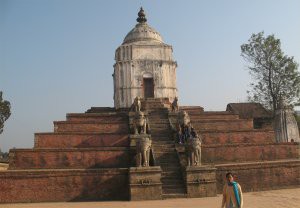 |
Siddha Pokhari near the main city gate.
It was built in the 15th Century during reign of King Yakshya Malla. |
| As well as a school, the palace of 55 windows also functions as an art gallery.
The art gallery of Bhaktapur Durbar Square contains ancient paintings belonging to the Hindu and Buddhist traditions of various periods. |
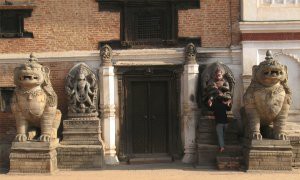 |
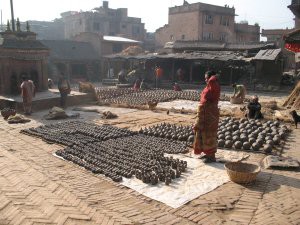 |
The typical occupation of the people are Pottery making, weaving and farming which are still practised in the same old manner passed through generations since medieval eras.
This picture shows Pottery square, one of the most famous places in Asia.
The selection of pottery for sale, would beggar Harrods. Its possible to have custom made pots, and watch it being made in front of you. |
| That evening there was a demonstration through the Town.
Local women were protesting at how they were treated as second class citizens within the Hindu faith. |
 |
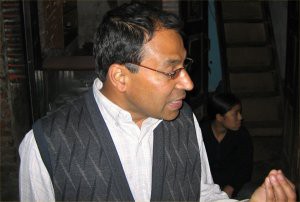 |
As our guide continues his tour, darkness falls.
He explained that the original palace had 99 courtyards, but the earthquake of 1934 destroyed most of them, and left only 7 remaining.
Chardham is believed to be the great pilgrimage for Hindus. Chardham was in India, but the old king was clever, and actually created one in Bhaktapur. |
| In an alleyway, our guide shows us this Peacock window.
Its a replica of a similar carved wooden windows which features on the Pujari Math. Once a monastery, it now used as a wood carving museum.
The Peacock window was a gift from German to celebrate the wedding of the King and Queen in 1973.
Its is considered once of the finest examples of wood carving in the world. |
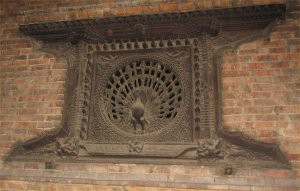 |
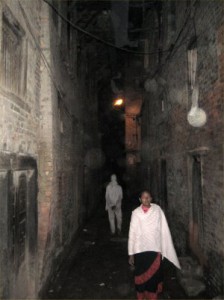 |
At night, we wander back to our hotel.
Once again a power cut had reduced the entire town to darkness.
To be honest, I found power cuts quite exciting !.
As we got up in the morning, we found that during the previous day, there had been a protest, and some poor fellow had been killed. His funeral was today, and although friendly, there was tension in the air.
The large military presence around Bhaktapur changed its appearance. It was still very spiritual but had a sinister undertones.
There were so many soldiers around the main temple, that we couldn’t actually photograph it.
It was sad to see it this way just before I left. |